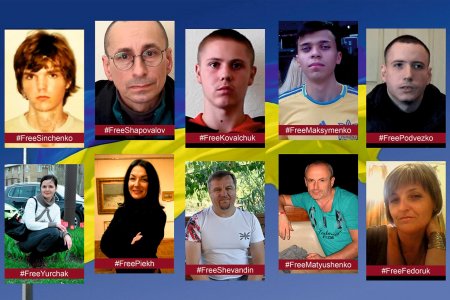
Disappearances occurred in Kharkiv — 1,874 cases, Kherson — 429 cases, Zaporizhzhia — 259 cases, Kyiv — 131 cases, Donetsk — 63 cases, Luhansk — 40 cases, and other regions. The number of disappearances recorded in the DB cannot be fully correlated with the indicators of the systematic and widespread Russian policy of attacks on civilians. The number of recorded cases of disappearances also depends on several other factors, such as the availability of information on disappearances in open sources, access to the place of disappearance, freedom of movement of the population between the territories, the date of de-occupation of the territory in question or the duration of the period of occupation, etc.
The largest number of enforced disappearances occurred at the beginning of the full-scale Russian invasion of Ukraine. In March 2022, 759 cases of disappearances were recorded in DB, constituting 26.7% of the total number of disappearances. Subsequently, the number of recorded cases gradually decreased until June-July 2022, when it reached approximately 120-160 persons per month, and remained at this level until mid-autumn 2022. After the de-occupation of part of the territory of Ukraine, namely the Kharkiv and Kherson regions, the number of enforced disappearances per month began to fall below 100 cases and continues to remain at this level to this day.
In some cases, we could not establish the exact date of disappearance, but only the possible period when it occurred. This is especially true in temporarily occupied territories, where it is impossible to determine precisely why a person stopped contacting us.
The documentation of enforced disappearances was additionally complicated by the lack of mobile or other communication with the temporarily occupied territories, which made it impossible to obtain specific and accurate information about the commission of crimes.
Also, Ukrainian law enforcement agencies could not operate in the temporarily occupied territories and properly investigate such crimes against humanity. Investigations were conducted remotely and were severely under-resourced, and therefore could not be effective. Law enforcement agencies did not have access to the scene and witnesses. Even after the de-occupation, it was almost impossible to recover traces of the crime in many cases, and witnesses were intimidated or had long ago left the territory and lived abroad. All this led to gaps in information about specific cases of enforced disappearances.
62% of the disappeared people were men (3,204 persons), while 34% were women (1,776 persons). The number of disappeared children amounted to 160 persons, or 4% of the total number. The collected data shows a trend of enforced disappearances predominantly men, who outnumbered women almost twice (62% of men vs. 34% of women).
The reason for committing crimes mainly against the male population was the Russian occupation authorities’ intention to prevent aggressive anti-Russian resistance. Men were seen as the most likely initiators of armed actions against the Russian authorities. Many were also suspected of direct or indirect cooperation with the AFU, while women were generally much less often charged with this accusation. The former (retired, dismissed) military personnel, law enforcement officers, and government officials refusing to cooperate with the Russian administration were detained.
Such people were predominantly male; thus, men became the main victims of Russian unlawful actions.
The small number of missing children indicates a general lack of intent to commit enforced disappearances against young children or minors. However, minors could have been victims of crimes against humanity if they were also suspected of collaborating with the AFU and aged 15-16. Younger children most often disappeared with their parents.
Women often disappeared together with their relatives and their husbands. There were also cases of group disappearances of women and disappearances of women after shelling (when wounded were taken to an unknown destination and disappeared). According to testimonies, in such instances, the wounded were often not allowed to contact their relatives for months and not being permitted to communicate any information about themselves during their stay in the hospital. After their stay in the hospital, some detainees were sent to filtration camps, where they were also restricted in communication with relatives.
Depending on the circumstances of the disappearance, we divided the disappeared into three groups: those who disappeared at home, on the road, and under unknown circumstances. We could find out that 374 persons went missing at home and 185 — while traveling. The disappearance of a person from their home involved an arrest preceded by a search or inspection of the house by the Russian military. During the search, the military usually found documents, belongings, and weapons that seemed suspicious to them and became the reason for the enforced disappearance.
Older people could also disappear from their homes, be taken by the Russian military in an unknown direction, and then stay somewhere without getting in touch. A similar fate awaited the wounded, including those injured during artillery shelling by the Russian military.
Disappearances on the road meant disappearances at checkpoints during document checks and while traveling between temporarily occupied settlements.
In other cases, the circumstances of the disappearance were unknown or poorly understood and required additional verification. Some people disappeared during the evacuation, trying to leave the temporarily occupied territories. These people could have been suspected during an inspection or search at the exit from the temporarily occupied territory and ended up in filtration camps or immediately accused of committing certain illegal acts.
There could be very diverse grounds for enforced disappearance. Most often, these grounds were denunciations. Initially, the Russian military had lists of people associated with state authorities, pro-government political forces, and law enforcement agencies. Such persons were the first to be detained, and then disappeared. However, over time, the practice of disappearances spread to other categories of people.
There have been cases of detention and enforced disappearance of persons who:
- expressed pro-Ukrainian stand in conversations;
- had members of the Armed Forces in their families;
- kept Ukrainian state symbols at home, spoke Ukrainian, and refused to switch to Russian;
- refused to cooperate, in particular, to teach children, deliver humanitarian aid, repair military equipment, etc.;
- had suspicious for Russian military contacts in their phones, photos, correspondence, subscriptions to social media channels or groups.
All of this could be the basis for a person’s detention and disappearance.
In addition, sometimes detentions took place for no reason as part of a policy of intimidation of the Ukrainian population.
Particular attention was paid to tattoos on people’s bodies. They were always inspected during a personal search. The person could be detained if the tattoos included any national Ukrainian symbols, symbols of the armed forces or individual units, and some other symbols. A person could also be detained even if they did not have such symbols but had tattoos that the Russian military could not interpret.
Foreigners who aroused the suspicion of the Russian military were also subjected to enforced disappearances. They could be US or European citizens or any foreigners who found themselves in the temporarily occupied territories.
We were able to establish that in 1,136 cases, the Russian military was involved in the disappearance, and in 32 cases — other related to Russian army persons, such as representatives of the so-called LPR or DPR, collaborators from the local population, etc. In most cases, we have not been able to identify the alleged perpetrators of specific enforced disappearances, but we continue to work on finding them.
Physical force was used against 998 disappeared persons during their detention. The use of physical force included beating during detention, demanding confessions or handing over certain things, extortion of money, and jewelry, requiring to name other people, etc. Such physical violence has been perpetrated in front of other settlement residents for intimidation. Victims of disappearances were taken away tied with ropes and with bags over their heads so they could not see where they were being taken. The reasons for detention were not announced on the spot, and the perpetrators provided no documents.
The homes of the disappeared were generally looted, with the most valuable items and household appliances taken. In some cases, enforced disappearances were committed just with a mercenary motive when entrepreneurs refused to cooperate and to give away their equipment and vehicles to the Russian military voluntarily.
Among the victims of enforced disappearances were identified 180 civil servants (primarily members of city or village communities who refused to cooperate), 90 former military and law enforcement and intelligence officers, 13 journalists, and 86 volunteers transporting humanitarian supplies or evacuating civilians.
Civil servants generally disappeared because they did not cooperate with the Russian military or even actively resisted it. There were cases of disappearances of civil servants who spoke at collective rallies at the beginning of the war when people tried to stop the Russian military in this way.
Volunteers were suspected of fire adjustments in favor of the Ukrainian Armed Forces and therefore were treated with particular suspicion.
The policy of enforced disappearances generally did not provide for cases of mass simultaneous disappearance of civilians. However, we know about 226 cases of disappearances when two or more persons disappeared simultaneously; 857 people became victims. So, on average, at least four people disappeared simultaneously during one incident. These were primarily families, roommates, or people traveling together between settlements.
Thus, throughout Ukraine, we see a uniform pattern of the crime of enforced disappearances. This pattern involved the temporary occupation of a settlement by the Russian army and the establishment of an interim administration. With the support of the military, such an interim administration conducted raids in a city or other settlement to identify persons potentially dangerous to the Russian authorities. The lists of such persons were often prepared in advance. They included political and public figures, former members of the Ukrainian Armed Forces (and their families), former law enforcement officials, judges, prosecutors, journalists, and volunteers.
Criminal actions were thus aimed at suppressing both armed and informational resistance, preventing forming a sustainable partisan or other movement that would express disagreement with Russian policy. Any freedom of speech was also restricted, which meant that the activities of journalists and public figures became grounds for their arrest and disappearance.
After the first wave of detention of those on the list, Russian agents continued their policy of enforced disappearances, creating an atmosphere of terror among the local population. Residents were encouraged to denounce each other, accuse each other, and pass on information to the Russian administration. It resulted in victims being often innocent people who had conflicts with neighbors or other close people. On the eve of the start of the school year (in July-August 2022), teachers who refused to teach the students using Russian textbooks also became victims of enforced disappearances.
The disappearance was preceded by a personal search or a search or inspection of the premises, which was conducted illegally. The documents confirming links to the Ukrainian state, authorities or security forces, military uniforms, weapons, suspicious photographs, conversations, contacts, state symbols of Ukraine, etc., were looked for during such searches. However, the person could still be subjected to enforced disappearance even if such items were not found. Some detainees were beaten immediately after being deprived of their liberty to intimidate or punish them. It is unknown whether the victims received medical care afterward, as there is no information about their whereabouts and conditions. In cases when the disappeared were found afterward, they reported the absence of any medical care.
After the person’s disappearance, the victim’s relatives could not obtain information from either the local occupation authorities or Russian Federation officials.
Receiving confirmation that the victim was under the Russian authorities’ control could happen months (and sometimes even more than a year) after the disappearance. However, even such confirmation did not contain information about the victim’s exact location and state of health. Therefore, the relatives of the disappeared continued to be in an informational vacuum, first not knowing whether the disappeared person was alive, then in what condition they were, and whether they had been subjected to violence. The Russian state authorities did not provide specific answers to inquiries and, in most cases, did not respond at all.
Ukrainian state authorities have no tools to force the Russian side to provide timely and truthful information, as it does not observe its international obligations. The Russian authorities do it intentionally, as formal responses from the Russian Federation, which do not contain specific circumstances of the crimes, are provided in mass by the same persons in all cases known to us. Such responses do not comply with international and national law, and the Russian leadership is well aware of this.
Thus, the analysis leads to the conclusion that the crimes against humanity were committed on a large scale, given the number of enforced disappearances we have recorded, and systematically, given the nature of their planning and the identity of the disappearance scenarios.
At the same time, the perpetrators were at different levels of government or military service. They included both direct perpetrators, persons who controlled the commission of the crime (military leadership) and accomplices. The perpetrators also included persons who, after the disappearance, did not provide truthful and accurate information about the fate of the disappeared, knowing that they were under the control of the Russian Federation.



